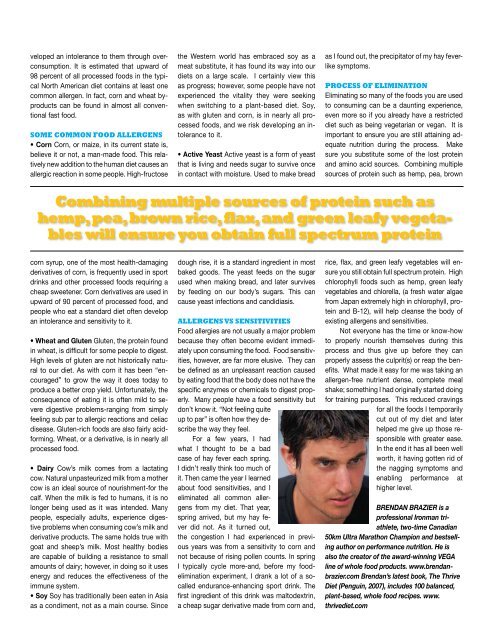JUSTIN HARTLEY SKINNY JEANS - LA Health News
JUSTIN HARTLEY SKINNY JEANS - LA Health News
JUSTIN HARTLEY SKINNY JEANS - LA Health News
You also want an ePaper? Increase the reach of your titles
YUMPU automatically turns print PDFs into web optimized ePapers that Google loves.
veloped an intolerance to them through overconsumption.<br />
It is estimated that upward of<br />
98 percent of all processed foods in the typical<br />
North American diet contains at least one<br />
common allergen. In fact, corn and wheat byproducts<br />
can be found in almost all conventional<br />
fast food.<br />
SOME COMMON FOOD ALLERGENS<br />
• Corn Corn, or maize, in its current state is,<br />
believe it or not, a man-made food. This relatively<br />
new addition to the human diet causes an<br />
allergic reaction in some people. High-fructose<br />
corn syrup, one of the most health-damaging<br />
derivatives of corn, is frequently used in sport<br />
drinks and other processed foods requiring a<br />
cheap sweetener. Corn derivatives are used in<br />
upward of 90 percent of processed food, and<br />
people who eat a standard diet often develop<br />
an intolerance and sensitivity to it.<br />
• Wheat and Gluten Gluten, the protein found<br />
in wheat, is difficult for some people to digest.<br />
High levels of gluten are not historically natural<br />
to our diet. As with corn it has been “encouraged”<br />
to grow the way it does today to<br />
produce a better crop yield. Unfortunately, the<br />
consequence of eating it is often mild to severe<br />
digestive problems-ranging from simply<br />
feeling sub par to allergic reactions and celiac<br />
disease. Gluten-rich foods are also fairly acidforming.<br />
Wheat, or a derivative, is in nearly all<br />
processed food.<br />
• Dairy Cow’s milk comes from a lactating<br />
cow. Natural unpasteurized milk from a mother<br />
cow is an ideal source of nourishment-for the<br />
calf. When the milk is fed to humans, it is no<br />
longer being used as it was intended. Many<br />
people, especially adults, experience digestive<br />
problems when consuming cow’s milk and<br />
derivative products. The same holds true with<br />
goat and sheep’s milk. Most healthy bodies<br />
are capable of building a resistance to small<br />
amounts of dairy; however, in doing so it uses<br />
energy and reduces the effectiveness of the<br />
immune system.<br />
• Soy Soy has traditionally been eaten in Asia<br />
as a condiment, not as a main course. Since<br />
the Western world has embraced soy as a<br />
meat substitute, it has found its way into our<br />
diets on a large scale. I certainly view this<br />
as progress; however, some people have not<br />
experienced the vitality they were seeking<br />
when switching to a plant-based diet. Soy,<br />
as with gluten and corn, is in nearly all processed<br />
foods, and we risk developing an intolerance<br />
to it.<br />
• Active Yeast Active yeast is a form of yeast<br />
that is living and needs sugar to survive once<br />
in contact with moisture. Used to make bread<br />
dough rise, it is a standard ingredient in most<br />
baked goods. The yeast feeds on the sugar<br />
used when making bread, and later survives<br />
by feeding on our body’s sugars. This can<br />
cause yeast infections and candidiasis.<br />
ALLERGENS VS SENSITIVITIES<br />
Food allergies are not usually a major problem<br />
because they often become evident immediately<br />
upon consuming the food. Food sensitivities,<br />
however, are far more elusive. They can<br />
be defined as an unpleasant reaction caused<br />
by eating food that the body does not have the<br />
specific enzymes or chemicals to digest properly.<br />
Many people have a food sensitivity but<br />
don’t know it. “Not feeling quite<br />
up to par” is often how they describe<br />
the way they feel.<br />
For a few years, I had<br />
what I thought to be a bad<br />
case of hay fever each spring.<br />
I didn’t really think too much of<br />
it. Then came the year I learned<br />
about food sensitivities, and I<br />
eliminated all common allergens<br />
from my diet. That year,<br />
spring arrived, but my hay fever<br />
did not. As it turned out,<br />
the congestion I had experienced in previous<br />
years was from a sensitivity to corn and<br />
not because of rising pollen counts. In spring<br />
I typically cycle more-and, before my foodelimination<br />
experiment, I drank a lot of a socalled<br />
endurance-enhancing sport drink. The<br />
first ingredient of this drink was maltodextrin,<br />
a cheap sugar derivative made from corn and,<br />
as I found out, the precipitator of my hay feverlike<br />
symptoms.<br />
PROCESS OF ELIMINATION<br />
Eliminating so many of the foods you are used<br />
to consuming can be a daunting experience,<br />
even more so if you already have a restricted<br />
diet such as being vegetarian or vegan. It is<br />
important to ensure you are still attaining adequate<br />
nutrition during the process. Make<br />
sure you substitute some of the lost protein<br />
and amino acid sources. Combining multiple<br />
sources of protein such as hemp, pea, brown<br />
Combining multiple sources of protein such as<br />
hemp, pea, brown rice, flax, and green leafy vegetables<br />
will ensure you obtain full spectrum protein<br />
rice, flax, and green leafy vegetables will ensure<br />
you still obtain full spectrum protein. High<br />
chlorophyll foods such as hemp, green leafy<br />
vegetables and chlorella, (a fresh water algae<br />
from Japan extremely high in chlorophyll, protein<br />
and B-12), will help cleanse the body of<br />
existing allergens and sensitivities.<br />
Not everyone has the time or know-how<br />
to properly nourish themselves during this<br />
process and thus give up before they can<br />
properly assess the culprit(s) or reap the benefits.<br />
What made it easy for me was taking an<br />
allergen-free nutrient dense, complete meal<br />
shake; something I had originally started doing<br />
for training purposes. This reduced cravings<br />
for all the foods I temporarily<br />
cut out of my diet and later<br />
helped me give up those responsible<br />
with greater ease.<br />
In the end it has all been well<br />
worth, it having gotten rid of<br />
the nagging symptoms and<br />
enabling performance at<br />
higher level.<br />
BRENDAN BRAZIER is a<br />
professional Ironman triathlete,<br />
two-time Canadian<br />
50km Ultra Marathon Champion and bestselling<br />
author on performance nutrition. He is<br />
also the creator of the award-winning VEGA<br />
line of whole food products. www.brendanbrazier.com<br />
Brendan’s latest book, The Thrive<br />
Diet (Penguin, 2007), includes 100 balanced,<br />
plant-based, whole food recipes. www.<br />
thrivediet.com



